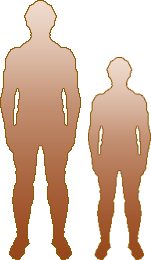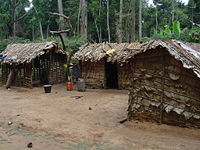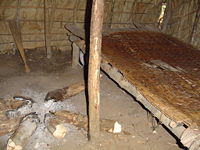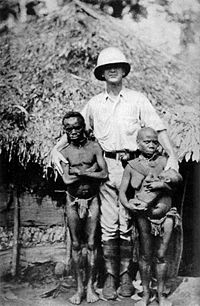Pygmy
Generally speaking, pygmy can refer to any human or animal of unusually small size (e.g. pygmy hippopotamus).
In an anthropological context, a Pygmy is specifically a member of one of the hunter-gatherer people living in equatorial rainforests, characterised by their short height (below 1.5 metres, or 4.5 feet, on average). Pygmies are found throughout central Africa, with smaller numbers in south-east Asia, New Guinea, and the Philippines (see Negrito), . Members of so-called Pygmy groups often consider the term derogatory, instead preferring to be called by the name of their ethnic group (e.g., Baka, Mbuti). The terms "forest foragers", "forest dwellers", and "forest people" have been used, but, for lack of an alternative, "Pygmy" remains the predominant term used throughout scientific circles.
Pygmies are smaller because in early adolescence they do not experience the growth spurt normal in most other humans. Endocrinologists consider low levels of growth hormone binding protiens to be at least partially responsible for the Pygmies' short stature.[1]
Pygmy References in History
The Pygmies are thought to be the first inhabitants of the African continent. The earliest reference to Pygmies is inscribed on the tomb of Harkhuf, an explorer for the young King Pepi II of Egypt. The text is a letter sent from Pepi to Harkuf around 2250 B.C.E., and describes the boy-king's delight at hearing that Harkuf would be bringing back a pygmy from his expidition, urging him to take particular care, exclaiming, "My Majesty longs to see this pygmy more than all the treasures of Sinai and Punt!" . [2] References are also made to a pygmy brought to Egypt during the reign of King Isesi, approximately 200 years earlier.
Later, more mythological references to Pygmies are found in the Greek literature of Homer, Herodotus, and Aristotle. Homer describes the "Three-Span (Trispithami) Pygmae who do not exceed three spans, that is, twenty-seven inches, in height; the climate is healthy and always spring-like, as it is protected on the north by a range of mountains; this tribe Homer has also recorded as being beset by cranes. It is reported that in springtime their entire band, mounted on the backs of rams and she-goats and armed with arrows, goes in a body down to the sea and eats the cranes' eggs and chickens, and that this outing occupies three months; and that otherwise they could not protect themselves against the flocks of cranes would grow up; and that their houses are made of mud and feathers and egg-shells."— Pliny Natural History 7.23-29 Aristotle also writes of Pygmies, stating that they come from the "marshlands south of Egypt where the Nile has its source." He goes on to state that the existance of the Pygmies is not fiction, "but there is in reality a race of dwarfish men, and the horses are little in proportion, and the men live in caves underground."[3]
In 1904, an American explorer named Samuel Verner was hired by the St. Louis World's Fair to bring back African pygmies for exhibition. Afterwards, he took the Africans back to their country. One Pygmy, named Ota Benga, returned to find that his entire tribe had been wiped out during his absence, and asked Verner to take him back to the United States. In September of 1906, he became part of a new exhibit at the Bronx Zoo, and was displayed in a cage in the Monkey House. The exhibit attracted up to 40,000 visitors a day, and sparked a vehement protest from African American ministers. Attempts to help Ota Benga live a normal life failed in March of 1916, when the African borrowed a gun from his host family, went into the woods, and shot himself.[4]
African Pygmies
There are many African Pygmy tribes throughout central Africa, including the Mbuti, Aka, BaBenzelé, Baka, Bing, Efé, Twa, and Wochua. Most Pygmies are nomadic, and obtain their food through a mix of foraging, hunting, fishing, and trading with inhabitants of neighboring villages. Their cultural identity is very closely tied to the rainforest, and likewise their spiritual or religious views. Music, as well as dance, is an important aspect of Pygmy life, and features various instruments and intricate vocal polyphony. Pygmies are often romantically portrayed as both utopian and "premodern", which overlooks the fact that they have long had relationships with more "modern" non-Pygmy groups (such as inhabitants of nearby villages, agricultural employers, logging companies, evangelical missionaries and commercial hunters. It is often said that Pygmies have no language of their own, speaking only the language of neighboring villagers, but this is not true. Both the Baka and Bayaka (sometimes referred to as the Aka), for example, have their own unique language distinct from that of neighboring villagers; the Bayaka speak Aka amongst themselves, but many also speak the Bantu language of the villagers. [5] Two of the more studied tribes are the Mbuti (who were the subject of the well known book The Forest People (1962) by Colin Turnbull, and the Baka.
The Mbuti
Enviroment
The Mbuti inhabit the Congo region of Africa, mainly in the Ituri forest in the Democratic Republic of Congo, and live in bands which are relatively small in size, ranging from 15 to 60 people. The Mbuti population is estimated to be about 30,000 to 40,000 people, though it is difficult to accurately assess a nomadic population. There are three distinct cultures, each with their own dialect, within the Mbuti. These are the Efe, which speak Balese, the Sua, who speak Bira, and the Aka who speak Mangbetu [5].
The forest of Ituri is a tropical rain forest, encompassing 70,000 square kilometers. In this area, there is a high amount of rainfall annually, ranging from 50 to 70 inches The dry season is relatively short, ranging from one to two months in duration. The forest is a moist, humid region strewn with rivers and lakes.[6] Diseases, such as sleeping sickness, are prevalent in the forests and can spread quickly, not only killing humans, but animal and plant food sources as well. [7] Too much rainfall or droughts can also affect the food supply.
Lifestyle
The Mbuti live much as their ancestors must have lived, leading a very traditional way of life in the forest. They live in territorially defined bands, and construct villages of small, circular, temporary huts, built from poles, rope made of vines, and covered with large leaves. Each hut houses a family unit. At the start of the dry season, they begin to move through a series of camps, utilizing more land area for maximum foraging. The Mbuti have a vast knowledge about the forest and the foods it yields. They hunt small antelope and other game with large nets, traps, and bows. [8].
Social Structure
There is no ruling group or lineage within the Mbuti, and no overlying political organization. The Mbuti are an egalitarian society where men and women basically have equal power. Issues in the community and decisions are made by consensus, and men and women engage in the conversations equally. There is not much political or social structure among the Mbuti. If there is a disagreement, misdemeanor, or offense, then the person may be banished, beaten, or scorned [5].
Whereas hunting with bow and arrow is usually a male activity, unting with nets is usually done in groups, with men, women, and children all aiding in the process. In some instances women may hunt using a net more often than men. The women and the children try to herd the animals to the net, while the men guard the net. Everyone engages in foraging, and both women and men take care of the children. Women are in charge of cooking, cleaning and repairing the hut, and obtaining water. The cooperative relationship between the sexes is illustrated by the following description of a Mbuti playful "ritual": "The tug-of-war begins with all the men on one side and the women on the other. If the women begin to win, one of them leaves to help out the men and assumes a deep male voice to make fun of manhood. As the men begin to win, one of them joins the women and mocks them in high-pitched tones. The battle continues in this way until the participants have switched sides and have had an opportunity to both help and ridicule the opposition. Then both sides collapse, laughing over the point that neither side gains in beating the other." [9]
Sister exchange is the common form of marriage [10]. Based on reciprocal exchange, men from other bands exchange their sister or another female that he has ties to [10]. In Mbuti society, bride wealth is not customary, and there is no formal marriage ceremony. Polygamy does occur, but is uncommon.
The Mbuti have a fairly extensive relationship with their Bantu villager neighbors. Never completely out of touch with the villagers, the Mbuti trade forest items such as meat, honey, and animal hides for agricultural products and tools. They also turn to the village tribunal in cases of violent crime. In exchange, the villagers turn to the Mbuti for their spiritual connection to the land and forest. Mbuti take part in major ceremonies and festivals, particularly those that have to do with harvests or the fertility of the land..[11]
Religion
Everything in the Mbuti life is centered on the forest; they consider themselves "children of the forest", and consider the forest to be a sacred place. An important part of Mbuti spiritual life is the molimo. The molimo is, in its most physical form, a musical instrument made most often from wood, (although, in The Forest People, Colin Turnbull described his disappointment that such a sacred instrument could also easily be made of old drainpipe.) To the Mbuti, the molimo is also the "Song of the Forest", a festival, and a live thing when it is making sound. When not in use, the molimo is kept in a tree, and given food, water, and warmth. The Mbuti believe that the balance of "silence" (meaning peacefulness, not the absence of sound) and "noise" (quarrelling and disharmony) is important; when the "noise" becomes out of balance, the youth of the tribe bring out the molimo. The molimo is also called upon whenever bad things happen to the tribe, in order to negotiate between the forest and the people. [12]
This sense of balance is evident in the song that the Mbuti sing over their dead:
There is darkness upon us; Darkness is all around, There is no light. But it is the darkness of the forest, So if it really must be, Even the darkness is good. [13]
Baka
The Baka, also known as Bebayaka, Bebayaga, Bibaya, or Babinga, are a Pygmy ethnic group inhabiting the southeastern rain forests of Cameroon, northern Congo (Brazzaville), northern Gabon, and southwestern Central African Republic. They are sometimes mistakenly called a subgroup of the Twa pygmies, but the two peoples are not closely related. Likewise, the name Baka is sometimes mistakenly applied to any of Cameroon's two to nine recognized pygmy populations. With an average height of 1.5 metres, the Baka are, strictly speaking, pygmoids rather than pygmies. Nevertheless, in everyday usage, the term "pygmy" is employed. The Baka themselves find the term "pygmy" derogatory and prefer their tribal name.
The Baka of the Democratic Republic of Congo and Sudan are an unrelated people.
The Baka's exact numbers are difficult to determine, but estimates range from 5,000 to 28,000 individuals.
Unlike most other Central African pygmy groups, the Baka maintain a unique language, also called Baka. It is included in the Adamawa-Ubangi branch of the Niger-Congo language family. In addition, many Baka speak Koozime, the tongue of their Bantu neighbours, as a second language. A much smaller percentage speak French.
The Baka are a hunter-gatherer people. Groups establish temporary camps of huts constructed of bowed branches covered in large leaves (though today more and more homes are constructed following Bantu methods). The men hunt and trap in the surrounding forest, employing poisoned arrows and spears to great effect. Meanwhile, the women gather wild fruits and nuts or practise beekeeping while tending to the children. The group remains in one area until it is hunted out then abandon the camp for a different portion of the forest. The group is communal and makes decisions by consensus.
Baka religion is animist. They worship a forest spirit known as Jengi or Djengi, whom they perceive as both a parental figure and guardian. Each successful hunt is followed by a dance of thanksgiving known as the Luma, which is accompanied by drumming and polyphonic singing. One of the most important traditional ceremonies is the Jengi, a long and secret rite of initiation which celebrates the boy's passage into adulthood, studied in depth by the anthropologist Mauro Campagnoli, who also could take part into it. The Baka practice traditional medicine, and their skills are such that even non-Baka often seek out pygmy healers for treatment.
The Baka live relatively symbiotically with their Bantu neighbours. They often set their camps along roadsides to better facilitate trade; the Baka provide forest game in exchange for produce and manufactured goods. Nevertheless, exploitation of the Baka by other ethnic groups is a grave reality, especially since the Baka are still largely unaccustomed to the cash-based economy. Non-Baka sometimes hire Baka pygmies as labourers, for example, but pay them virtually nothing for a full day's work. Or, conscious of the tourism potential, some non-Baka arrange visits or stays in pygmy villages or arrange Baka guides for visitors to forest reserves, often with little compensation to the pygmies. Rates of Baka-Bantu intermarriage are also on the rise. Baka who marry outside of their ethnic group typically adopt the lifestyle of their non-Baka spouse, so some scholars predict that the pygmies will one day be completely assimilated into other groups.
The Baka are among the oldest inhabitants of Cameroon and the neighbouring countries. Their semi-nomadic lifestyle has persisted largely unchanged for thousands of years, despite the fact that during colonialism, the Baka's prowess at elephant hunting prompted ivory-hungry German and French overlords to force them to settle in roadside villages where their talents could be more easily exploited. The government of Cameroon, while stopping short of forced settlement, has attempted to maintain this policy through government incentives and regulations such as mandatory schooling for all children. However, the Baka largely resist. Today, the greatest threat to their way of life comes from multinational logging interests. As the forests disappear, the animals and plants upon which the Baka rely vanish as well.
Asian Negrito
Among the Asian groups are the Agta and the Batak (in the Philippines), the Semang (on the Malay Peninsula) and the residents of the Andaman Islands.
The Negritos include the Ati, the Aeta and at least 4 other tribes of the Philippines, the Semang of the Malay peninsula, and 12 Andamanese tribes of the Andaman Islands. The Malay term for them is orang asli, or original people. They are likely the indigenous people of south-east Asia, including New Guinea. Pygmy-sized, they are numerically and physically among the smallest as well as among the least-known of all living human races. The Negrito peoples have one of the purest genetic pools of mitochondrial DNA (mtDNA) among anyone in humankind so their mtDNA serves as a baseline in studying Genetic Drift.
The word is the Spanish diminutive of Negro, i.e. "little Black", and was given by early explorers who thought that the Negritos were from Africa.
The Negritos of the Philippines could make fire, whereas the Andamanese could not. The Semang are recorded to have made clothing of pounded tree bark, and to have lived in both caves and leaf-covered shelters. The Negritos are believed to be the aborigines of the Philippines. They are distinct from the Austronesian peoples who arrived in boats or balangay (see Barangay). (See Antique, Philippines for the 1212 purchase of rights, by some Malay peoples, to settle on the island of Panay from the chief of the Negritos there).
Notes
- ↑ Baumann, Shaw, Merimee (1989-06-29). Low levels of high-affinity growth hormone-binding protein in African pygmies. The New England Journal of Medicine. Retrieved October 16, 2006.
- ↑ John Ray. Voices from Ancient Egypt Gallery. BBC. Retrieved October 17, 2006.
- ↑ Aristotle. Ancient Greek Online Library. Greek Texts. Retrieved October 17, 2006.
- ↑ NPR. NPR: From the Belgian Congo to the Bronx Zoo. NPR. Retrieved October 18, 2006.
- ↑ Daniel Duke. Aka as a Contact Language: Sociolinguistic and Gramatical Evidence. Retrieved October 23, 2006.
- ↑ Ehret, Christopher. 1998. The Civilizations of Africa Charlottesville, VA: University Press of Virginia.
- ↑ Traditional Cultures. Prospect Heights, IL: Waveland Press.
- ↑ Mukenge, Tshilemalea. 2002. Culture and Customs of the Congo Westport, CT:Greenwood Press
- ↑ Efe and Mbuti. Thompson Gale. Retrieved October 23, 2006.
- ↑ 10.0 10.1 Mukenge, Tshilemalea. 2002. Culture and Customs of the Congo Westport, CT:Greenwood Press
- ↑ John Hart (1984-10-30). The Mbuti of Zaire. Cultural Survival Quarterly. Retrieved October 23, 2006.
- ↑ William Miller. A View from the Inside. Linfield College. Retrieved October 23, 2006.
- ↑ Paul Salopek (9-2005). Mbuti Pygmies @National Geographic Magazine. National Geographic. Retrieved October 23, 2006.
Bibliography
- Fanso, V.G. (1989) Cameroon History for Secondary Schools and Colleges, Vol. 1: From Prehistoric Times to the Nineteenth Century. Hong Kong: Macmillan Education Ltd.
- Neba, Aaron, Ph.D. (1999) Modern Geography of the Republic of Cameroon, 3rd ed. Bamenda: Neba Publishers.
External links
- Baka Pygmies Culture, music and life of Baka Pygmies, by Mauro Campagnoli
- The Mbuti of Zaire
Credits
New World Encyclopedia writers and editors rewrote and completed the Wikipedia article in accordance with New World Encyclopedia standards. This article abides by terms of the Creative Commons CC-by-sa 3.0 License (CC-by-sa), which may be used and disseminated with proper attribution. Credit is due under the terms of this license that can reference both the New World Encyclopedia contributors and the selfless volunteer contributors of the Wikimedia Foundation. To cite this article click here for a list of acceptable citing formats.The history of earlier contributions by wikipedians is accessible to researchers here:
The history of this article since it was imported to New World Encyclopedia:
Note: Some restrictions may apply to use of individual images which are separately licensed.



